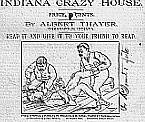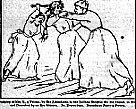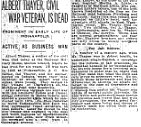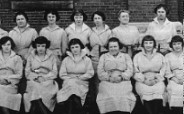On the surface, CSH seemed to be a fairly pleasant place. A closer look, however, reveals some unsavory realities. For decades, the hospital confined its "worst inmates", those who screamed incessantly or who were bellicose, to the basement or the "dungeons" of the hospital. In 1870, CSH superintendent, Dr. Everts, was so appalled by the wretched condition of the dungeons that he reported it to the Governor:
"basement dungeons (are) dark, humid and foul, unfit for life of any kind, filled with maniacs who raved and howled like tortured beasts, for want of light, and air, and food, and ordinary human associations and habiliments..."
Worse yet, he exclaimed, the normal wards were "without adequate or intelligent provision for light, heat, or ventilation" and patients were forced to sleep on "beds all straw upon forbidding skeletons of iron". Repairs to the hospital structure were rarely made due to insufficient funds causing "abundant leakages" and rotten floors. Pantries and kitchen space were infested with cockroaches.
Unfortunately, Hoosier politicians did not heed Evert's words. In 1872, Dr. Everts, a frustrated and defeated man, resigned. But the work of Dr. Evert and like-minded reformers was not completely in vain: finally, in 1880, the legislature appointed an investigating committee to review charges of staff misconduct at state penal and charitable institutions.
 "Indiana Crazy House," Albert Thayer, circa 1880s (99.7 KB)
"Indiana Crazy House," Albert Thayer, circa 1880s (99.7 KB)
Albert Thayer, a Civil War veteran, a publisher, and a CSH patient, shared Dr. Evert's reformist zeal. After being discharged from CSH in 1884, Thayer published exposes on CSH and other state institutions. Appalled by the poor treatment that he and other patients received at CSH, Thayer convinced former CSH patients to publish their stories in a broadside entitled, "The Indiana Crazy House," and in The Rough Diamond, a Thayer publication devoted to helping workers and the poor of Indiana.

"Indiana Crazy House, " page 3 (66.8 KB)
Thayer attributed most abuses to politicians, both democrats and republicans, who provided insufficient funding for the hospital which, in turn, led to understaffing, the hiring of poorly trained help, patient abuse, and inadequate food for patients.
Albert Thayer's obituary, Indianapolis News, October 1, 1920(113 KB) In addition, Thayer sent pre-printed letters to churches across the state asking them to speak out against "the corruptions and abuses in the Indiana Hospital for the Insane and the State Prison South." Thayer, an active member of Post 165 of the Grand Army of the Republic (G.A.R), also spurred a movement among G.A.R. members to end the poor treatment of Union veterans and their widows and orphans at state charitable institutions.
In addition, Thayer sent pre-printed letters to churches across the state asking them to speak out against "the corruptions and abuses in the Indiana Hospital for the Insane and the State Prison South." Thayer, an active member of Post 165 of the Grand Army of the Republic (G.A.R), also spurred a movement among G.A.R. members to end the poor treatment of Union veterans and their widows and orphans at state charitable institutions.
 CSH Medical Attendants, early 1900s
CSH Medical Attendants, early 1900s
Fortunately, in the 1880s and 90s, reform-minded superintendents and community activists successfully lobbied for more funding to improve the hospital's appearance. But patient abuse continued. Medical attendants, not physicians, continued to be the primary care takers. Due to the low wages and the long hours the hospital offered, CSH was unable to attract high-caliber, well-trained personnel. Some did care for the patients with compassion, but many treated patients horribly. Attendants were known to hit patients, lock them in closets, and restrain them in bed for long periods of time. Many would punish patients if they spoke to one another, silencing them for hours on end.
The attendants, however, were not completely to blame. Abuses occurred, in part, due to understaffing and poor training. The widely-held, nineteenth-century belief that the mentally ill could control their actions and were at fault for their deviant behavior also factored into the abuse equation. At this time, attendants, as well as many Victorians, including some physicians, strongly believed that the mentally ill could be coaxed into normal adulthood through punishment, confinement, and "moral" training.
While our understanding and treatment of mental illness progressed in the twentieth century, patient abuse was an ongoing problem. At CSH, patient abuse continued to be a problem until its closure in 1994. In fact, lurid tales of patient abuse played a major role in the dismantling of Central State Hospital.
